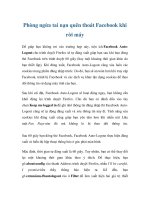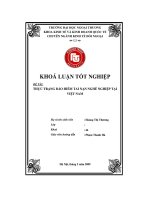Phòng ngừa tai nạn nghề nghiệp
Bạn đang xem bản rút gọn của tài liệu. Xem và tải ngay bản đầy đủ của tài liệu tại đây (3.27 MB, 61 trang )
AN TOÀN CHO NHÂN VIÊN Y TẾ
•
Một vấn đề quan trọng
• Một chương trình triển khai trong BV
• Một chính sách của nghành y tế
BS.CKII.Nguyễn Thị Thanh Hà
TK.CNK. Bệnh Viện Nhi Đồng 1
Phó chủ tịch, Tổng thư Ký Hội KSNK Tp HCM
Chương trình bao gồm
1. Chích ngừa vaccin viêm
gan B cho NVYT.
2. Có sẵn thùng đựng
vật sắc nhọn trong BV.
3. Huấn luyện cho NVYT:
Sử dụng trang phục
phòng hộ cá nhân,
Giảm tần suất tai nạn do
vật sắc nhọn,
Giảm nguy cơ phơi nhiễm
với máu và dịch cơ thể,
Vật sắc nhọn
ÒNG NGỪA PHƠI NHIỄM VỚI MA
DỊCH CƠ THỂ Ở NHÂN VIEÂN Y
PHƠI NHIỄM CỦA NHÂN VIÊN Y TẾ
(U.S. DEPARTMENT OF HEALTH AND HUMAN SERVICES
Public Health Service Centers for Disease Control and Prevention
National Institute for Occupational Safety and Health, 1998)
•
Case 1
A hospitalized patient with AIDS became agitated and tried to
remove the intravenous (IV) catheters in his arm.
Several hospital staff members struggled to restrain the patient.
During the struggle, an IV infusion line was pulled, exposing the
connector needle that was inserted into the access port of the IV
catheter.
A nurse at the scene recovered the connector needle at the end of
the IV line and was attempting to reinsert it when the patient kicked
her arm, pushing the needle into he hand of a second nurse.
The nurse who sustained the needlestick injury tested negative for
HIV that day, but she tested HIV positive several months later
•
[American Health Consultants 1992a].
Phơi nhiễm của nhân viên y tế
(U.S. DEPARTMENT OF HEALTH AND HUMAN SERVICES
Public Health Service Centers for Disease Control and Prevention
National Institute for Occupational Safety and Health, 1998)
Case 2
A physician was drawing blood from a patient in an
examination room of an HIV clinic. Because the room
had no sharps disposal container, she recapped the
needle using the one-handed technique.
While the physician was sorting waste materials
from lab materials, the cap fell off the phlebotomy
needle, which subsequently penetrated her right index
finger.
The physician.s baseline HIV test was negative. She
began post-exposure prophylaxis with zidovudine
but discontinuedit after 10 days because of adverse
side effects.
Approximately 2 weeks after the needlestick, the
physician developed flu-like symptoms consistent
with HIV infection.
She was found to be seropositive for HIV when tested 3
months after the needlestick exposure
NIOSH
(Publications Dissemination 4676 Columbia Parkway
Cincinnati, OH 45226.1998)
Case 3
In 1972, a nurse sustained a needlestick njury to her finger while
removing a hypodermic needle from a patient.s arm. At the time of the
injury, the source patient had apparent acute non-A, non-B hepatitis.
The nurse developed hepatitis 6 weeks after the needlestick injury. Her
liver enzymes remained elevated for nearly a year. Later examination
of serum samples from the nurse and the source patient showed that
both persons were infected with HCV.
The initial serum sample from the nurse in 1972 was negative for antiHCV antibody, but the sample obtained 6 weeks after the needlestick
injury was seropositive. Although the nurse was clinically well at the
time of the report,
she remained seropositive for HCV
Tributes to nurses at the hospital
who have died.
Credit Samuel Aranda for The New York Times
Josephine Finda Sellu, deputy nurse matron
at a government hospital in Kenema, Sierra
Leone, where 15 Ebola nurses have died.
Nhân viên y tế và Ebola
• Ngồi Tây Phi:17 trường hợp nhiễm bệnh đang được điều trị. Hầu
hết trong số đó là các NVYT ngoại quốc bị nhiễm Ebola ở Tây Phi
và được chuyển về đất nước của họ để điều trị.
• Mỹ: 1 người đàn ơng Liberia bắt đầu có triệu chứng nhiễm bệnh 4
ngày sau khi tới Dallas, sau đó là 2 NVYT ở Dallas bị nhiễm khi điều
trị cho người đàn ơng Liberia..
• Tây Ban Nha: 1 nữ y tá người bị lây bệnh sau khi tham gia chăm
sóc cho 2 nhà truyền giáo ở bệnh viện Madrid;
• Tây Phi: Hơn 400 NVYT ở đã bị nhiễm Ebola kể từ khi đại dịch này
xảy ra cho đến nay. Trong số đó, 233 người đã chết, tính đến thời
điểm ngày 8/10.
• WHO: lây nhiễm cao trong số các NVYT có thể là do tình trạng thiếu
hoặc khơng sử dụng thiết bị PHCN, thiếu nhân lực và phải làm việc
trong khu vực cách ly suốt thời gian dài .
Costs of Management of Occupational
Exposures
to Blood and Body FluidsAuthor(s) Emily
M. O'Malley, MSPH, R. Douglas Scott II, PhD, Julie Gayle, MPH, John Dekutoski, MD, Michael Foltzer, MD,
Tammy S. Lundstrom, MD, JD, Sharon Welbel, MD, Linda A. Chiarello, RN, MS, and Adelisa L. Panlilio, MD,
MPHIdentifiers Infection Control and Hospital Epidemiology, volume 28 (2007), pages 774–782
Thực hiện: 4 cơ sơ y tế/ năm
- 600 giường
- 244 giường
- 437 giường
Kết quả:
- TS phơi nhiễm: 31 trường hợp
- Chi phí: 71 – 4.838 USD ( làm test, thuốc điều trị dự phòng, theo dõi)
+ HIV ( có hoặc không kết hợp với B hoặc C (19 người): 2 456 (907 –
4.838 UDS)
+ BN không rõ nguồn NK (6 người) : 376 (71 – 860 USD )
+ VG C (4 người) : 650 (186 – 856) USD
Kết luận:
Nếu làm tốt an toàn cho NVYT chúng ta sẽ không mất khoản tiền
quản lý và điều trị phơi nhieãm
ĐẶT VẤN ĐỀ
• NVYT và tai nạn nghề nghiệp
Tai nạn thường gặp trong quá trình
chăm sóc và điều trị BN
Đây là một cấp cứu nội khoa
Có rất nhiều văn bản hướng
dẫn NVYT khi chăm sóc BN HIV.
Dự phòng cho NVYT khi có tiếp
xúc với máu và dịch tiết của BN
là một vấn đề đảm bảo an toàn
nghề nghiệp cho NVYT
AN TOÀN CHO NVYT ?
NVYT phải được học về dự phòng phơi nhiễm,
NVYT khi bị tai nạn phải có trách nhiệm khai báo
NVYT phải được thử test HBV_HIV ngay khi vào làm
ở BV
Thử test ngay khi có phơi nhiễm và theo dõi sau đó
nếu (+)
Báo cáo phơi nhiễm cho những người có trách
nhiệm
Ghi nhận và lưu trữ,
Theo dõi phơi nhiễm
A
HIV
VIEÂM
GAN_HIV
B
C
D
E
G
PHÂ
N BỐHBV TRÊ
N THẾGIỚ
I
>8% - High
2%-7%
<2% - Low
/>
Hepatitis B and HCW









